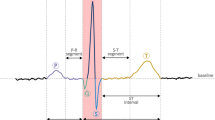Abstract
The paper presents an algorithm for reducing false alarms related to changes in arterial blood pressure (ABP) in intensive care unit (ICU) monitoring. The algorithm assesses the ABP signal quality, analyses the relationship between the electrocardiogram and ABP using a fuzzy logic approach and post-processes (accepts or rejects) ABP alarms produced by a commerical monitor. The algorithm was developed and evaluated using unrelated sets of data from the MIMIC database. By rejecting 98.2% (159 of 162) of the false ABP alarms produced by the monitor using the test set of data, the algorithm was able to reduce the false ABP alarm rate from 26.8% to 0.5% of ABP alarms, while accepting 99.8% (441 of 442) of true ABP alarms. The results show that the algorithm is effective and practical, and its use in future patient monitoring systems is feasible.
Similar content being viewed by others
References
Berne, R. M., andLevy, M. N. (1997): ‘Cardiovascular physiology’ (Mosby-Year Book, Inc., St. Louis, Missouri, 1997)
Cao, C., Kohane, I. S., andMcIntosh, N. (1999): ‘Artifact detection in cardiovascular time series monitoring data from preterm infants’. Proc. AMIA Symp., pp. 207–211
Crew, A. D., Stoodley, K. D. C., Lu, R., Old, S., andWard, M. (1991): ‘Preliminary clinical trials of a computer-based cardiac arrest alarm’,Intens. Care Med.,17, pp. 359–364
Feldman, J. M., Ebrahim, M. H., andBar Kana, I. (1997): ‘Robust sensor fusion improves heart rate estimation: clinical evaluation’,J. Clin. Monit.,13, pp. 379–384
Goldberger, A. L., Amaral, L. A. N., Glass, L., Hausdorff, J. M., Ivanov, P. C., Mark, R. G., Mietus, J. E., Moody, G. B., Peng, C. K., andStanley, H. E. (2000): ‘PhysioBank, Physio-Toolkit, and PhysioNet: components of a new research resource for complex physiologic signals’,Circulation,101, pp. e215-e220
Lawless, S. T. (1994): ‘Crying wolf: false alarms in a pediatric intensive care unit’,Crit. Care Med.,22, pp. 981–985
Makivirta, A., Koski, E., Kari, A., andSukuvaara, T. (1991): ‘The median filter as processor for a patient monitor limit alarm system in intensive care’,Comput. Methods Programs Biomed.,34, pp. 139–144
Moody, G. B., andMark, R. G. (1982): ‘Development and evaluation of a 2-lead ECG analysis program’,Comput. Cardiol.,9, pp. 39–44
Moody, G. B., andMark, R. G. (1991): ‘The MIT-BIH Arrhythmia Database on CD-ROM and software for use with it’,Comput. Cardiol.,18, pp. 185–188
Moody, G. B., andMark, R. G. (1996): ‘A database to support development and evaluation of intelligent intensive care monitoring’,Comput. Cardiol.,23, pp. 657–660
O'Rourke, M. F., Kelly, R. P., andAvolio, A. P. (1992): ‘The arterial pulse’ (Lea & Febiger, Malvern, PA, 1992)
Pedrycz, W., andGomide, F. (1998): ‘An introduction to fuzzy sets: analysis and design’ (MIT Press, Cambridge, MA, 1998)
Rheineck-Leyssius, A. T., andKalkman, C. J. (1998): ‘Influence of pulse oximeter settings on the frequency of alarms and detection of hypoxemia: theoretical effects of artifact rejection, alarm delay, averaging, median filtering or a lower setting of the alarm limit’,J. Clin. Monit. Comput.,14, pp. 151–156
Tsien, C. L., andFackler, J. C. (1997): ‘Poor prognosis for existing monitors in the intensive care unit’,Crit. Care Med.,25, pp. 614–619
Tsien, C. L., andKohane, I. S. (1998): ‘Using multi-signal integration to detect false alrms in intensive care unit’,Med. Decis. Making,18, p. 469
Tsien, C. L., Iohane, I. S., andMcIntosh, N. (2000): ‘Multiple signal integration by decision tree induction to detect artifacts in the neonatal intensive care unit’,Artif. Intell. Med.,19, pp. 189–202
Watt, R. C., Maslana, E. S., andMylrea, K. C. (1993): ‘Alarms and anesthesia’,IEEE Eng. Med. Biol. Mag.,12, pp. 34–41
Zadeh, L. A. (1965): ‘Fuzzy sets’,Inform. Control.,8, pp. 338–353
Zadeh, L. A. (1983): ‘The role of fuzzy logic in the management of uncertainty in expert systems’,Fuzzy Sets Syst.,11, pp. 199–227
Zong, W., andJiang, D. (1998): ‘Automated ECG rhythm analysis using fuzzy reasoning’,Comput. Cardiol.,25, pp. 69–72
Zong, W., Moody, G. B., andMark, R. G. (1999): ‘Reduction of false blood pressure alarms by use of electrocardiogram blood pressure relationships’,Comput. Cardiol.,26, pp. 305–308
Zong, W., Heldt, T., Moody, G. B., andMark, R. G. (2003): ‘An open-source algorithm to detect onset of arterial blood pressure pulses’,Comput. Cardiol.,30, pp. 259–262
Author information
Authors and Affiliations
Corresponding author
Rights and permissions
About this article
Cite this article
Zong, W., Moody, G.B. & Mark, R.G. Reduction of false arterial blood pressure alarms using signal quality assessement and relationships between the electrocardiogram and arterial blood pressure. Med. Biol. Eng. Comput. 42, 698–706 (2004). https://doi.org/10.1007/BF02347553
Received:
Accepted:
Issue Date:
DOI: https://doi.org/10.1007/BF02347553




